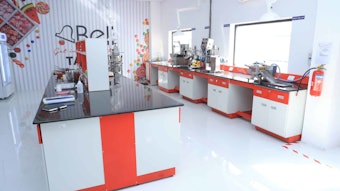New technology report
Enhancement of Shelf Life and Flavor Profile for Encapsulated Orange Oil: A case study in microencapsulation processing technology developed using the lead user process
A new microencapsulation processing technology was found to increase protection against oxidation substantially while also exhibiting a significant increase in low-molecular-weight volatile organic compound retention. This patent-pending process (FONATech Clean Flavor Technology, or CFT), developed using the lead user process, is based loosely on contemporary spray-drying techniques. The objective of this research is to determine and verify the performance of this new process technology. The data represented herein details notable differences between a CFT microencapsulated orange oil versus a typical spray dry of the same oil and carrier system.
The analysis of the CFT and the traditional spray dry microencapsulates encompassed a full array of analytical techniques (i.e., total oil determination, surface oil determination, moisture analysis, headspace analysis). This communication will outline the results of an accelerated shelf-life study regarding the presence of limonene oxides, L-carvone and carveols. The shelf-life study was conducted in the following manner. Samples of each encapsulate were stored in a container representative of the packaging material commonly used for warehousing microencapsulated products. Representative containers then were placed in an incubator regulated at 45°C for a time period to simulate six months of shelf life. The products then were pulled from storage and prepared for analytical evaluation.
The analysis consisted of determining the remaining levels of limonene alongside the generation of off-taste components (i.e., limonene epoxides, carvone). This was accomplished by solvent extraction preparation, followed by separation on a gas chromatograph. The quantitative determinations utilized both an internal standard and correction factors for detector response. The results are reported in T-1.
The presented data firmly established the reduction of oxidation and off-flavor proliferation contributed by limonene degradation. Although the analytical data exhibited notable differences with concentrations of limonene and its oxidation products, these differences extended to the organoleptic evaluation of this material. FONA’s sensory group conducted a difference test on the materials to see if there was a perceivable difference between the flavor profile of the CFT microencapsulation and non-CFT spray dry in a sweetened beverage. The results showed that there was a significant difference between the samples at the 99.9% confidence level. The group commented that CFT-processed materials had a cleaner organoleptic presence regarding the natural orange profile, including the retention of the brightness attributes of the orange oil. This contrasted with the non-CFT-processed flavor that exhibited an adulterated profile, lack of brightness and off-note lingering.
Current flavor families using the CFT technology include citrus, exotics, mints, fruits and certain savory applications. Future work for this technology includes examination of functional ingredients and thermally labile components that could benefit from this microencapsulation process.










